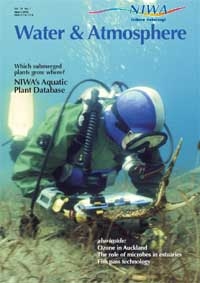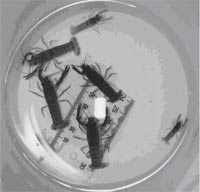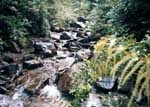PDF of this article (2 MB)

Ian Jowett Robert Milhous
Settling sediment means that river water tends to clear as it flows downstream, but this is not always a good thing.
Some years ago, during construction of the Pukaki Dam in central South Island, a small amount of turbid glacial water from Lake Pukaki flowed down the Pukaki River. Immediately below the dam, the water was the blue-grey colour associated with the glacial lakes, but a kilometre or so farther downstream it was clear. The river bed was acting as a filter. This process has resulted in people describing the river bed as a “silt reservoir”, where silt is stored during normal flows and released during floods when water velocities are high enough to disturb the bed or flush sediment from backwater areas.
Dead zones in rivers

All natural river channels contain “dead zones”, or areas of low velocity. Dead zones may include pools, backwaters and embayments, water within dense beds of macrophytes (water plants) or thick mats of periphyton (algae), and water behind cobbles or boulders or in the interstices of a gravel bed. Mixing processes carry suspended sediment into these low-velocity zones where particles settle out and accumulate until re-suspension.
As soon as suspended sediment is introduced into a channel, it begins to deposit in dead zones. The result is that turbidity decreases in the downstream direction provided that there are no additional sources of suspended sediment.
The idea that all rivers get clearer as they flow downstream may appear to contradict another common observation: that water is clear in the headwaters but far from clear when it flows into the sea. This reduction in clarity is the result of extra suspended-sediment inputs that occur between the headwaters and the sea.
Whether or not water clears as it flows downstream, silt will still build up. This is why natural floods or flushing flows in controlled rivers are important for cleansing the bed of accumulated sediment.
Predicting suspended sediment

In April 2001 we collected water samples along a 60-km length of the Rangitata River. These samples showed how suspended-sediment concentration decreased with distance downstream (at least until a discharge from an irrigation scheme caused a slight increase). The measured decrease in suspended sediment concentration was similar to that predicted using theory and instream habitat survey measurements of channel form and velocity (see graph).
The rate at which suspended sediment settles and the rate at which a river clears depend on the particle size of the suspended sediment. Large particles such as sand settle out very quickly whereas fine sediments can take much longer. Our calculation assumed that the suspended sediment had a uniform particle size of 0.002 mm, which corresponds to very fine silt.
In the Rangitata River, we were well downstream of the sediment source in the mountains and all coarse sediment had probably settled out leaving a relatively uniform suspension. However, more work will be carried out to validate this model for higher suspended-sediment concentrations and flows.
Management implications


Photographs of a turbid stream and a clear stream, showing the fine sediment deposits in the turbid stream, and no surface deposition of fine sediments in the clear stream. Both are in East Cape, North Island. (Photos: Jody Richardson)
If the flow in a river reduces – as a result of either natural low flows or man-made abstractions or diversions – water velocities will also be lower. Assuming that the suspended-sediment concentration stays the same, this means that there is more time for fine particles to settle out. Thus, for any natural flow and its associated turbidity, flow abstraction increases the rate at which suspended sediment will deposit and turbidity in downstream reaches decreases. Hence the water becomes clearer than it would be without abstraction.
Most people would regard this as a beneficial outcome of water abstraction, but you don’t get anything for nothing. Salmon anglers have their greatest chance of catching fish when the river is slightly turbid because salmon seem to be reluctant to strike lures when the water is clear. Large reductions in flow could make the salmon rivers too clear for anglers.
A clearer river downstream also means that more sediment must be depositing on or in the stream bed. Although gravel-bed rivers have a large capacity to store sediment, gravels and other dead-zone storage could become overloaded if upstream sediment concen-trations and the amount of water abstracted are high. This has a deleterious effect on the habitats occupied by benthic invertebrates and many of our native fish species. These effects are currently being studied and a recent publication (see Further reading) shows how a small amount of deposited sediment can have a relatively large effect on upland bullies.
Teachers: this article can be used for Planet Earth and Beyond L7 A.O. 1/2 and L5 A.O. 1/2. See other curriculum connections at www.niwa.co.nz/pubs/wa/resources
Ian Jowett is based at NIWA in Hamilton; Robert Milhous is from the US Geological Survey, Fort Collins, Colorado, and was a visiting scientist at NIWA in 2001.
Further reading
Jowett, I.G.; Boustead, N.C. (2001). Effects of substrate and sedimentation on the abundance of upland bullies (Gobiomorphus breviceps). New Zealand Journal of Marine and Freshwater Research 35: 605–613.
